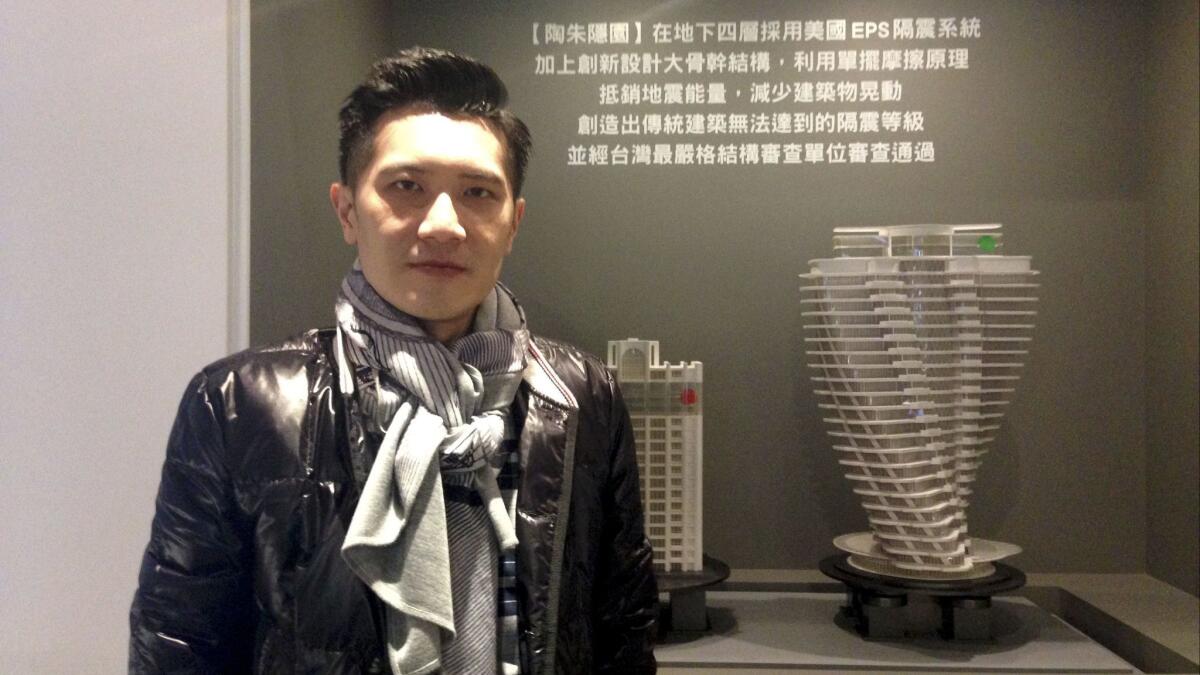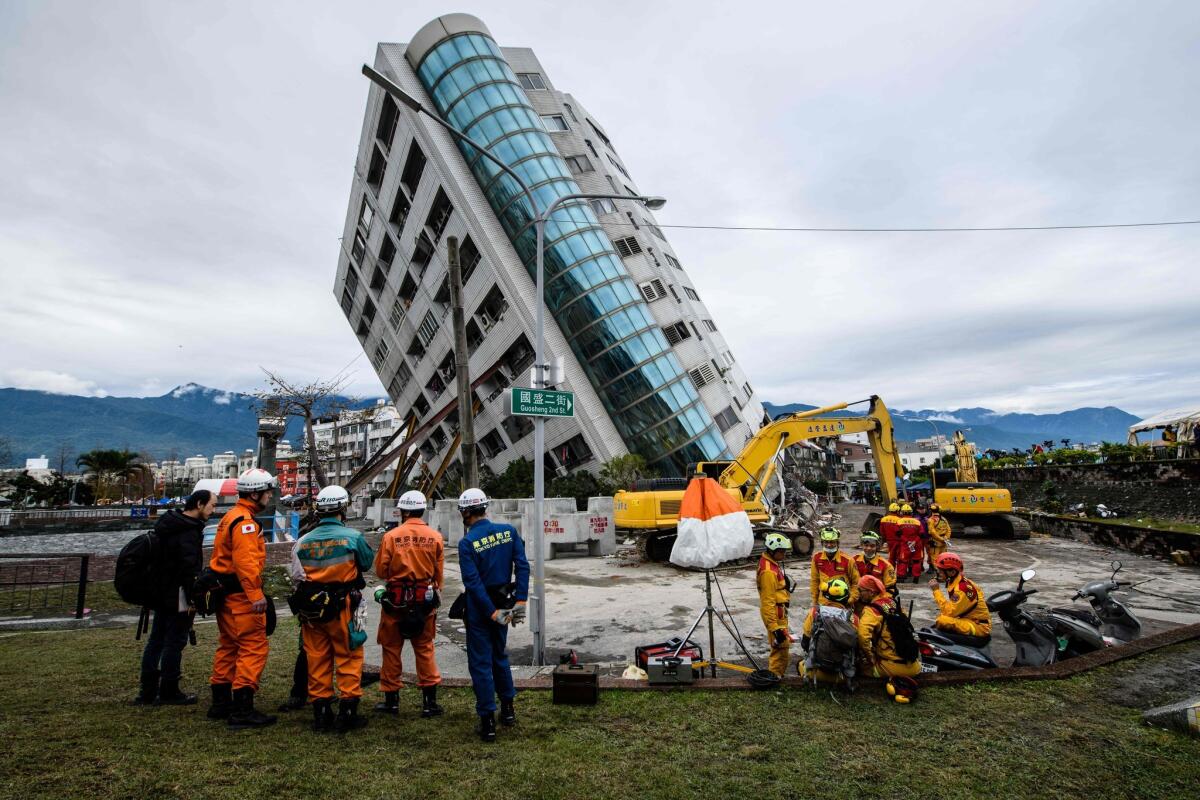It took a deadly earthquake to get Taiwan’s attention, but now it’s demanding safer buildings
- Share via
Eliot Shen, project manager for a property developer in Taipei, has installed buffers under a new corkscrew-shaped, high-end apartment tower. The goal is to stop Taiwan’s frequent earthquakes from sending destructive energy upward into the building.
The builders put lightweight, expanded polystyrene blocks under the 21-level tower as absorbers. Then they left empty space around the foundation so the base can shake in a strong magnitude-7 earthquake without affecting the structure above it.
Shen’s employer, BES Engineering, uses a 2-foot-high building model in its offices to show visitors how the technology works as the actual tower nears completion this year. The model sits still as the ground – a shelf – jolts from side to side. “We separate out the quake,” said Shen, who is also special assistant to the firm’s CEO. “When a quake comes, the building structural system won’t be affected.”

Shen may be ahead of the curve. Countless cost-wary property owners in Taiwan have sidestepped quake safety over the decades despite numerous warnings and disasters. But after a deadly quake Feb. 6, the central government said it would require reviews of more than 34,000 existing structures and, for the first time, make their owners ensure safety. Officials had only recommended upgrades before.
Taiwan’s Cabinet announced those measures last month, along with pledges to quicken disaster response times. Most of Taiwan’s 23 million people live in multilevel buildings like the four that partly collapsed in the Feb. 6 quake, fanning fears of more disasters.
Builders say the island’s mostly brick and concrete buildings risk collapsing in earthquakes because of soft soil and reliance on columns of rebar inside walls rather than steel I-beams for structural support.
They cite particular risks to weak lower stories, which can bring down a high-rise if damaged. Many of Taiwan’s urban buildings are mixed commercial and residential, with larger ground-level floors sparing beams to maximize store and office space. In California, experts also worry about brittle concrete buildings and those with soft first floors used for parking, storefronts or hotel lobbies.
“Earthquakes are common in Taiwan and frequently cause severe damage,” Prime Minister William Lai said at a Feb. 26 news conference. “We hope people will help and cooperate. We can’t let these things happen again.”
Retrofits will start with a “quick screening” this year of all structures that are more than nine floors high and move on to those as low as six stories by 2021, Interior Minister Yeh Jiunn-rong told the news conference.
More than 99% of publicly owned structures are safe, according to Lai.
Officials have goaded property owners in the past with findings such as a March 2016 study showing that areas of eight Taiwanese cities and counties were highly vulnerable to structural collapse in an earthquake because of their soil composition. Owners often fret over values of properties that are tagged as earthquake-prone. Construction codes also changed after 1999 for new structures.
The Feb. 6 earthquake, which measured magnitude 6.4, killed 17 people under collapsed buildings in the eastern county of Hualien. A quake two years ago toppled a building and killed 116 people in a populous southern city. In 1999, Taiwan experienced its worst earthquake in recent memory, a magnitude 7.1 event that left 2,400 people dead.

Taiwan sits on an earthquake “ring of fire” that also touches Japan and California.
The government will offer some building owners subsidies for safety appraisals, the interior minister said. As inspections unfold, the Cabinet will order local fire departments to inspect buildings for safety hazards such as any remodeling that has compromised support beams. Owners of apartments, stores and offices typically alter walls and floors to taste before moving in.
To evacuate people faster during earthquakes, President Tsai Ing-wen called in a speech last month for a stronger “anti-earthquake system.”
As part of that system, local governments should collect more information on who lives where and collect more people’s phone numbers so telecom providers can send text message alerts as early as possible, even while a longer-lasting quake is still shaking, Cabinet spokesman Hsu Kuo-yung said.
After the Feb. 6 quake, local rescue officials knew only who was registered as living in the damaged structures rather than who was actually in them. Registration does not require that people actually live where they register.
The new building safety and disaster response measures will still fall short of making Taiwan earthquake-safe, some citizens and building industry experts fear.
Taiwanese do not always see the urgency of earthquake safety, said Wei Yu-ting, a 26-year-old Taipei resident who’s following the legal changes.
California could be hit by an 8.2 mega-earthquake, and it would be catastrophic »
“A lot of time the laws are there but the enforcement is inadequate,” Wei said. “The hardware comes along but the software lags.”
Taiwan’s rescue officials should rely more on satellites, drones and remote sensing to locate people quickly under the dense rubble of collapsed buildings, said Tsai Fu-an, a professor with the Center for Space and Remote Sensing Research at National Central University in Taiwan.
A lot of Taiwan’s older buildings simply cannot be retrofitted, said Sampson Mar, a Taipei-based former member of the U.S. Green Building Council. Many were built a half-century ago, when the economy entered its major modern boom cycle and construction was quick and under-regulated.
Those structures would need to be torn down, he said. Walls lack support, he said, while most structures in the Taipei basin of more than 6 million people are built on soft soil rather than bedrock. “It’s just lucky that more buildings don’t come down,” Mar said.
In 2013, former Interior Minister Lee Hong-yuan warned that 4,000 structures could fall in a magnitude 6.3 quake, and the Pacific Rim sees many bigger ones.
Before 1980, Taiwan was relatively poor, had few professional architects and lacked understanding of quake safety, local publisher and historian Yang Lian-fu said. Developers sometimes cut corners and use connections in local government to get permits instead of submitting to the rigorous reviews required overseas, Yang said.
Officials at a Feb. 26 news conference to announce the tougher earthquake safety measures did not say how they would enforce compliance after changing the construction law.
“We know that for quite some time people didn’t care about these regulations,” said Jens Damm, associate professor in the Graduate Institute of Taiwan Studies at Chang Jung Christian University in Taiwan. “Getting rich was a priority.”
ALSO
Jennings is a special correspondent.
Sign up for Essential California
The most important California stories and recommendations in your inbox every morning.
You may occasionally receive promotional content from the Los Angeles Times.







